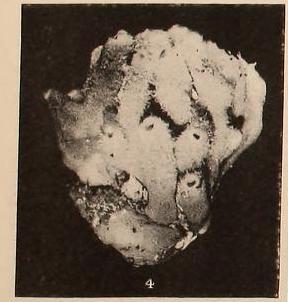
Sponges or sea sponges are primarily marine invertebrates of the metazoan phylum Porifera, a basal animal clade and a sister taxon of the diploblasts. They are sessile filter feeders that are bound to the seabed, and are one of the most ancient members of macrobenthos, with many historical species being important reef-building organisms.

Hexactinellid sponges are sponges with a skeleton made of four- and/or six-pointed siliceous spicules, often referred to as glass sponges. They are usually classified along with other sponges in the phylum Porifera, but some researchers consider them sufficiently distinct to deserve their own phylum, Symplasma. Some experts believe glass sponges are the longest-lived animals on earth; these scientists tentatively estimate a maximum age of up to 15,000 years.
Arturia tenuipilosa is a species of calcareous sponge from Sri Lanka. The name refers to the very thin, hair-like oxea present in this species.

The orange wall sponge is a species of sea sponge belonging to the order Trachycladida. It is found in the south Atlantic and Indo-Pacific oceans. Around the South African coast, it is known from the Cape Peninsula to Cape Agulhas.

Spongilla lacustris is a species of freshwater sponge from the family Spongillidae. It inhabits freshwater rivers and lakes, often growing under logs or rocks. Lacustris is a Latin word meaning "related to or associated with lakes". The species ranges from North America to Europe and Asia. It is the most common freshwater sponge in central Europe. It is the most widespread sponge in Northern Britain, and is one of the most common species of sponges in lakes and canals. Spongilla lacustris have the ability to reproduce both sexually and asexually. They become dormant during winter. The growth form ranges from encrusting, to digitate, to branched, depending upon the quality of the habitat.
Agelas flabelliformis, also known as the elephant ear sponge, is a species of demosponge. It takes the form of a large leathery slender flap and is found in the Caribbean area at depths down to 100 metres (330 ft).
Neopetrosia subtriangularis is a species of marine petrosiid sponges native to the waters off Florida and the Caribbean Sea. They superficially resemble staghorn corals.

Synodontis melanostictus is a species of upside-down catfish endemic to Lake Tanganyika and its tributaries. It has been found in Zambia, the Democratic Republic of the Congo, and Burundi. It was first described by British-Belgian zoologist George Albert Boulenger in 1906, based upon a specimen from the Lofubu River. The species name "melanostictus" is derived from a combination of the Greek melano, meaning black, and the Greek stiktos, meaning punctured or spotted. This refers to the black spotted pattern that occurs on the body of this species.

Geodia megastrella is a species of sponge in the family Geodiidae. It is a type of demosponge found in the deep temperate waters of the North Atlantic Ocean. It has characteristic stellar-shaped large spicules coined 'megastrellum', hence its name. The species was first described by Henry John Carter in 1876, after dredging it up aboard H.M.S. 'Porcupine', near the Cape St. Vincent in Portugal.
Biemna variantia is a species of sponge in the family Biemnidae. It is native to the northwestern Atlantic Ocean, the northeastern Atlantic Ocean, the North Sea and the Mediterranean Sea. This species was first described in 1858 by the British naturalist James Scott Bowerbank, who gave it the name Halichondria variantia. It was later moved to the genus Biemna and is the type species of the genus. The type locality is Tenby, Wales.
Hymeniacidon kitchingi is a species of sponge in the class Demospongiae. It is found in shallow waters in the northeastern Atlantic Ocean. This species was first described in 1935 by the British zoologist Maurice Burton. He placed it in a new genus because of its unusual spicules, and named it Rhaphidostyla kitchingi, in honour of Dr J. A. Kitching, who had collected the original specimen. It was later transferred to the genus Hymeniacidon.
Vosmaeropsis macera is a species of calcareous sponge in the family Heteropiidae, and was first described in 1886 by Henry John Carter as Heteropia macera, and was later described as Vosmaeropsisis dendyi by Row and Hôzawa in 1931. It is the type species of the genus, Vosmaeropsis. The species epithet, macera, comes from the Latin, macer.

Vosmaeropsis mackinnoni is a species of calcareous sponge in the family Heteropiidae, and was first described in 1924 by Arthur Dendy and Leslie M. Frederick. It is known only from its type locality in the Abrolhos Islands, in Western Australia.
Mycale anisochela, the brain sponge, is a species of demosponge from South Africa and Namibia.
Polymastia bouryesnaultae, the knobbly sponge, is a small and cryptic species of demosponge from South Africa and Namibia.
Suberites dandelenae, the amorphous solid sponge, is a species of deep-sea demosponge from South Africa and Namibia.
Penares sphaera, the crater sponge, is a deep sea demosponge from southern Africa.

Tetilla is a genus of demosponges in the family Tetillidae. It is widely distributed. They are mainly found in deeper habitats.
Tetilla capillosa, the furry sponge, is a species of demosponge from southern Africa.
Rossella antarctica is a relatively small species of glass sponge. It is widely distributed in the southern hemisphere, particularly in the Antarctic and sub-Antarctic regions.







